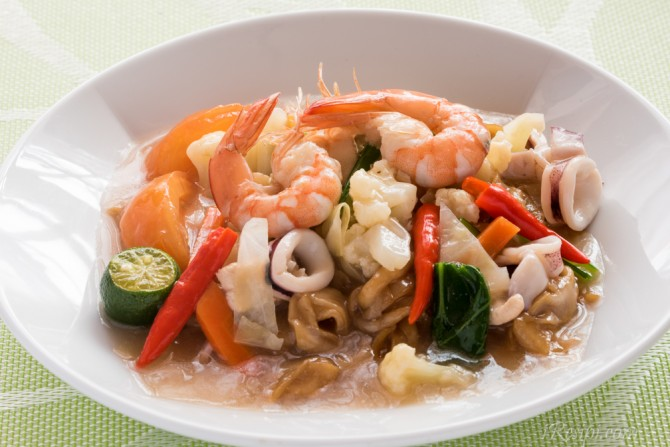Kong Fu Chow, Ying Yong, Or Kuey Teow Ladna? Here's Why The Dish Has 10 Different Names
What do you call this dish?
Did you know Yin Yong Kong Fu Chow, or Cantonese fried yee mee, has many names? And depending on what you call it, you might get a slightly different version of the dish
Depending on whom you ask, where you order it, and what language or dialect the cook speaks, the name of this fried noodles covered in velvety egg gravy dish changes. But not always!
Essentially, the dish gets most of its names from this: Yin Yong Kong Fu Chow (鸳鸯广府炒). The literal translation of the Cantonese name is 'Mandarin ducks fried Cantonese'.
Not to be confused with Yin and Yang, the philosophy of dualistic harmony, 'Yin Yong' refers to Mandarin ducks that often appear in ancient literary works, myths, and legends.
'Yin' is the male duck, while 'Yong' refers to the female. The term has long symbolised love, as these ducks are always seen in pairs. Over time, it has come to represent inseparable objects or people that appear together — much like the dish, which is often served with two types of noodles.
As for 'Kong Fu', it does not mean the martial art kung fu. 'Kong' refers to Cantonese, while 'Fu' translates to prefecture. Naming a dish after its place of origin is common, and this dish is no exception.
Lastly, 'Chow' translates to 'fried'. It is phonetically similar to 'char', as in char kuey teow. Regardless of how it is romanised, 'chow' and 'char' are essentially the same word. 'Chow' just happens to be the more popular spelling, but both romanisations can be used interchangeably.
So, what should you call the dish?
Here are 10 names of the dish you need to know and their differences, if any:
1. Ying Yong
A shortened name for Yin Yong Kong Fu Chow, highlighting the duality of noodles: typically kuey teow and deep-fried vermicelli.
2. Char Ying Yong
This name, which translates to Fried Ying Yong, better emphasises the dish itself rather than its reference to Mandarin ducks.
3. Wat Tan Hor
Wat Tan Hor (滑蛋河) is also a common way of calling the dish. Its literal translation from Cantonese is 'smooth egg gravy flat rice noodles'.
However, calling the dish this name means you will be served with hor fun instead of kuey teow. While both noodles are made with the same ingredients, hor fun is the thicker and broader version.
If texture matters to you, be sure to ask the cook whether they are using hor fun or kuey teow, as some small vendors might use them interchangeably.
4. Char Hor Fun
Adding 'char' to hor fun creates another name for the same dish, which translates to 'fried flat rice noodle'.
5. Hua Dan Sheng Mian
Hua Dan Sheng Mian (滑蛋生面) is the Mandarin way of calling the dish. 'Hua Dan' and 'Wat Tan' are the same words.
Meanwhile, 'Sheng Mian' refers to 'raw noodles', which are typically dough-based.
The sheng mian is deep-fried before serving. Calling it Hua Dan Sheng Mian, or just Sheng Mian in some places, means you will only be getting one type of noodle. In some establishments, the dish is called Hai Xian Sheng Mian (海鲜生面), emphasising that it is served with seafood.
If you are looking for a combination of two noodles — deep-fried vermicelli and kuey teow, or hor fun — then this is not your order.
6. Kong Foo Chow
Kong Foo Chow is a shortened name for Yin Yong Kong Fu Chow. It is served with deep-fried vermicelli and kuey teow or hor fun.
7. Kuey Teow Kung Fu
This name is typically used by Malay and tom yam restaurants.
Instead of serving with deep-fried vermicelli or deep-fried sheng mian, the kuey teow is deep-fried after being coated with eggs.
Since the eggs are cooked with the kuey teow, the gravy typically does not contain eggs unless specified otherwise to the cook.
8. Kuey Teow Hong Kong
Kuey Teow Hong Kong is another name for Kuey Teow Kung Fu, using the same cooking method.
9. Cantonese Fried Yee Mee
Cantonese Fried Yee Mee is the same velvety egg gravy dish.
But instead of deep-fried vermicelli or sheng main, and kuey teow or hor fun, it is served with yee mee, a variety of flat Cantonese egg noodles made from wheat flour.
Since yee mee is already pre-cooked, most restaurants typically don't cook the noodles before serving. This gives the dish a crispy texture, similar to other variants on this list.
10. Kuey Teow Ladna
Lastly, Kuey Teow Ladna has similar characteristics as the rest, but the kuey teow is never fried.
The noodle is instead stir-fried with kicap manis (sweet soy sauce).
If you are having this at a Thai restaurant, you will be served with limau kasturi and prik nam pla (fish soy sauce and chilli padi, among other ingredients).











